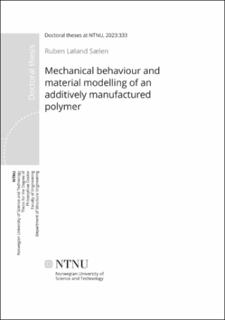| dc.description.abstract | This thesis presents the characterisation and constitutive modelling of the mechanical behaviour of a commercial additively manufactured polymer produced with the stereolithography process. The first part of the characterisation procedure consisted of an extensive experimental campaign carried out to provide experimental data for use in the calibration and validation of a constitutive model. The material was studied through tensile and compression tests on smooth and notched axisymmetric specimens. The tests revealed the material to be practically isotropic and to have a strain-rate- and pressure-dependent yield stress. Test specimens failed in tension with a brittle fracture mode, yet the surface logarithmic strains measured with DIC before fracture exceeded 0.4 in all cases. After testing, hardly any permanent deformations were observed which indicates that the mechanical response is primarily viscoelastic. In addition to the tensile and compression tests, tests were performed on more complex 3D-printed structures to provide validation data for the constitutive model implemented as part of this thesis. The first validation test series consisted of quasi-static and dynamic compression tests of octet-strut lattice structures. The results from the quasi-static tests showed the same strain-rate sensitivity as the tensile tests, while the dynamic tests exhibited an extremely brittle failure mode due to the high strain rates. The second validation test series consisted of three-point bending tests of notched beams with two different notch radii. These tests did not reveal anything new about the mechanical behaviour of the material but provided experimental data with more complex stress states than the tension and compression tests.
Based on the experimental results, a constitutive model was formulated and implemented as a user-material in the finite element solver Abaqus/Explicit. The model is hyper-viscoelastic and formulated for large strains using a multiplicative split of the deformation gradient. A stress-based fracture initiation model with stochastic critical stress was employed to model the brittle fracture modeobserved in the experiments. The implemented constitutive model was verified by investigating its behaviour in single-element simulations at various stress- and strain states. The model was then calibrated to the experimental results from the tension and compression tests by an inverse modelling approach. The model was able to capture the stress-strain response from the experiments as well as predict the fracture initiation. The validation tests were then simulated with the calibrated material model.
Simulations of the quasi-static octet-strut lattice structures agreed well with the experimental results. Both the force-displacement curves and deformation modes were captured by the model. Simulations of the dynamic lattice compression tests revealed that the combination of a stress-based fracture criterion and the nonlinear viscoelasticity of the model was able to predict the same brittle behaviour seen in the experiments. Simulations of the three-point bending tests captured the experimental trends, but the force at yield was underestimated for both specimen types which led to fracture occurring too late. Fracture propagation was not accurately captured by the fracture model as the simulated crack paths were heavily mesh dependent and did not match the experimental results. | en_US |
